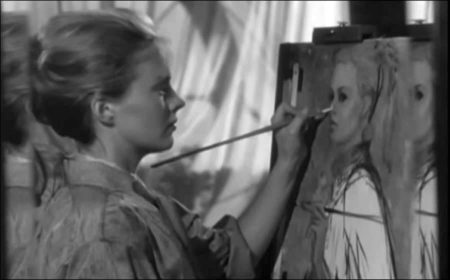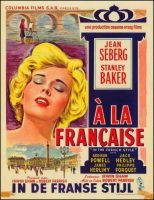Taglines: It’s Paris… It’s Irwin Shaw… It’s In the French Style.
In the French Style movie storyline. The young American student Christina James (Jean Seberg) comes to Paris to live in the art scene. After six months in Paris, she meets sixteen-year-old Guy (Philippe Forquet) at a crowded gallery showing and their romance develops. Later, she enjoys encounters with European men. Her Chicago-based history professor father (Addison Powell) cautions her about fleeting love. She abandons a long-time attachment to a British international journalist (Stanley Baker) to marry the San Francisco, California surgeon Dr. John Haislip (James Leo Herlihy).
In the French Style is a 1963 French-American romance film released by Columbia Pictures directed by Robert Parrish and stars Jean Seberg, Stanley Baker, Philippe Forquet, Addison Powell, Jack Hedley, Maurice Teynac, James Leo Herlihy, Ann Lewis, Jacques Charon, Claudine Auger and Barbara Sommers. It was based on a short story by Irwin Shaw.
Film Review for In the French Style
As with any major film star who dies young, Jean Seberg has become a cult of personality to some film fans, partly due to the fact that she died in Paris from an overdose of barbiturates at age 40 in 1979. Her death was ruled a suicide but conspiracy theories still abound because she was deemed a political radical by the FBI due to her association with far left wing causes and her support of the Black Panther party.
On screen, however, Seberg’s characters were generally not radical, although her breakthrough film did find her as the female lead in Godard’s classic 1960 crime flick Breathless. Still, there were some hints of Seberg’s liberated woman persona in her early career. One such film was In the French Style, a largely forgotten 1963 production based on Irwin Shaw’s novel. Shaw wrote the screenplay and the film was directed by Robert Parrish, a respected veteran of the movie industry who never enjoyed a career-defining major hit. (The closest he came was directing segments of the bloated 1967 spoof version of Casino Royale.)

The movie opens in Paris with Seberg as Christina James, a 19 year old free spirited girl from Chicago who has come to the City of Light to hone her skills as a painter. In the process of trying to acclimate herself to the metropolitan lifestyle, she meets Guy ((Philippe Forquet), a headstrong, sometimes arrogant 21 year-old who is nonetheless charismatic and quite handsome. He woos Christina and before long, they are a couple swept up in a whirlwind romance. However, it isn’t long before there are strains due in part to their impoverished lifestyle. Guy, being a typical guy, tries to get Christina into bed, but she says when it happens, it will be on her terms and conditions.
When the big moment arises, Guy’s romantic evening turns into a disaster because he only has enough money to rent a room at a flophouse hotel without heat. In the course of the strained evening, Guy confesses to Christina that he cannot perform sexually because he is too nervous. He makes a shocking confession: he is actually a 16 year old high school boy and a virgin at that.
While this does bring the story into a completely unexpected direction, it’s the one element of the film that strains credibility largely due to the fact that Forquet was actually 23 years old at the time and looks it. Nevertheless, this plot device takes us away from what was shaping up as a conventional “boy meets girl” romance and plunges the viewer into unknown waters.

The story then jumps ahead in time and we find Christina now in her early twenties and very much in step with the Parisian lifestyle. She is the toast of her neighborhood’s social scene and the belle of the ball in terms of attracting male suitors. In a rather progressive depiction of a single woman for the year 1963, it is made abundantly clear that Christina has her pick of lovers and routinely engages in short-term sexual affairs.
Every time she meets the “right man”, it turns out that differences in their lifestyles prevent them from enjoying a traditional relationship. Her father (very well played by Addison Powell) visits her from Chicago and, again Shaw’s script goes against the conventional depiction of father and daughter relationships generally seen in movies during this era. Instead of being a square old fuddy duddy, Dad is actually amused by his daughter’s somewhat hedonistic lifestyle and he asks her how many lovers she has had.
“A couple”, she replies, but it becomes clear that both of them regard that as a drastic understatement. When her father asks to see the paintings she has been working on for years, he gently informs her that they are below the quality he had expected. He cautions her that her party-filled lifestyle may be compromising her potential. Christina objects and two part company under a strain, but it becomes clear that her father’s words have resonated with her and that it might be time to develop plans for a more productive career path.
All of that changes when she has a chance encounter with Walter Beddoes (Stanley Baker), a hard-drinking international newspaper journalist. They enjoy a torrid affair and fall in love but, alas, fate rears its ugly head once again when Walter’s requirements to travel extensively takes him away from Christina for months at a time. He confesses to her that, while abroad “I don’t live like a monk”. Christina says she accepts that he will have other lovers but makes it clear that she will, too.
Such behavior from a young couple was rarely depicted so honestly on screen in 1963, an era in which sexually assertive women were generally painted as floozies. By the time Walter returns from a three month stint in Africa, he finds Christina has a new boyfriend, an American doctor from San Francisco (James Leo Herlihy), who she says she intends to marry. She has a civilized lunch with both men, as Walter tries to persuade her to resume her affair with him.
She confesses that she has seen her share of former lovers ultimately drop her to marry the girl of her dreams, a status she somehow never attains in their eyes. This climactic sequence left me a bit disappointed because in the end, Christina- that most liberated of young women- decides to throw in the towel to become a doctor’s wife and live in San Francisco. However, director Parrish does afford us the nagging possibility that she knows she is selling out by doing so.
In the French Style is a very worthwhile experience. The Parisian locations add immeasurably to its pleasures and the crisp B&W cinematography Michel Kelber is impressive, as is the Joseph Kosma’s atmospheric score. Not much happens dramatically in the film. You keep waiting for some earth-shaking development to emerge but it never does. However, that’s part of the movie’s charm. It recalls an era in which studios routinely backed small films with fine actors (they are all wonderful here) and gave them intelligent dialogue and direction.
In the French Style (1963)
Directed by: Robert Parrish
Starring: Jean Seberg, Stanley Baker, Philippe Forquet, Addison Powell, Jack Hedley, Maurice Teynac, James Leo Herlihy, Ann Lewis, Jacques Charon, Claudine Auger, Barbara Sommers
Screenplay by: Irwin Shaw
Production Design by: Roger Ferret, Ludmilla Goulian
Cinematography by: Michel Kelber
Film Editing by: Renée Lichtig
Art Direction by: Rino Mondellini
Music by: Joseph Kosma
MPAA Rating: None.
Distributed by: Columbia Pictures
Release Date: September 18, 1963
Views: 279


